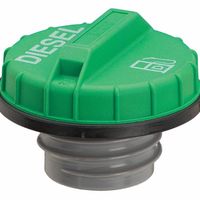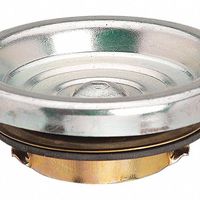Call +(254) 703 030 000 / 751 483 999 / 721 704 777
Fuel & Oil Caps
Fuel, oil, and gas caps fit securely on vehicles to reduce spillage and eliminate evaporation. Locking gas caps add a layer of security, and help prevent fuel and oil theft. Exhaust caps eliminate intake of dirt, dust, debris, snow, and rain blowing or falling into an exposed stack pipe. Radiator ca .....Read More
Frequently Asked Questions
What is the purpose of a fuel cap on a vehicle?
The purpose of a fuel cap on a vehicle is to seal the fuel tank, preventing fuel evaporation and contamination. It ensures that the fuel system remains closed, maintaining the pressure necessary for efficient fuel delivery to the engine. This helps in reducing emissions by preventing volatile organic compounds (VOCs) from escaping into the atmosphere, which is crucial for meeting environmental regulations.
The fuel cap also acts as a barrier against dirt, debris, and moisture, which could otherwise enter the fuel tank and potentially cause damage or reduce the efficiency of the fuel system. By keeping the fuel clean, it helps in maintaining the performance and longevity of the engine.
Additionally, the fuel cap plays a role in safety. It prevents fuel spillage, which could lead to fire hazards, especially in the event of an accident. A properly sealed fuel cap also helps in preventing fuel theft, as it typically requires a key or a specific mechanism to open.
Modern fuel caps are often equipped with a pressure relief valve that allows for the safe release of excess pressure, protecting the fuel tank from damage due to pressure build-up. Some vehicles have a tethered cap to prevent loss, while others have a capless system for convenience.
Overall, the fuel cap is a small but essential component that contributes to the vehicle's efficiency, safety, and environmental compliance.
How do locking gas caps prevent fuel theft?
Locking gas caps prevent fuel theft by providing a physical barrier that restricts unauthorized access to the fuel tank. These caps are equipped with a lock-and-key mechanism or a combination lock, which ensures that only individuals with the correct key or combination can open the cap. This deters potential thieves from siphoning fuel, as they cannot easily remove the cap to access the fuel tank.
The locking mechanism is typically made of durable materials, such as metal or reinforced plastic, making it resistant to tampering or forced entry. This adds an additional layer of security, as it requires more time, effort, and tools to bypass, which can discourage thieves who prefer quick and easy targets.
Moreover, locking gas caps often have a design that integrates seamlessly with the vehicle's fuel system, making it difficult to remove without causing noticeable damage. This can serve as a further deterrent, as thieves are less likely to attempt theft if it risks drawing attention or causing damage that could lead to detection.
In addition to preventing theft, locking gas caps can also protect against vandalism or contamination of the fuel supply. By securing the fuel tank, they prevent unauthorized individuals from introducing harmful substances into the tank, which could damage the vehicle's engine or fuel system.
Overall, locking gas caps serve as an effective deterrent against fuel theft by combining physical security with the inconvenience and risk of detection for potential thieves.
What are the benefits of using an exhaust cap?
An exhaust cap, also known as a vent cap or chimney cap, offers several benefits:
1. **Weather Protection**: It prevents rain, snow, and debris from entering the exhaust system, which can cause blockages or corrosion.
2. **Animal Prevention**: It keeps birds, rodents, and other animals from nesting or entering the exhaust system, which can lead to blockages and potential hazards.
3. **Improved Efficiency**: By preventing blockages, an exhaust cap ensures that the system operates efficiently, maintaining optimal airflow and reducing the risk of backdrafts.
4. **Corrosion Prevention**: By keeping moisture out, it reduces the risk of rust and corrosion within the exhaust system, prolonging its lifespan.
5. **Spark Arrestor**: Some exhaust caps are designed to prevent sparks from escaping, reducing the risk of fire, especially in areas prone to wildfires.
6. **Odor Control**: It helps in directing exhaust fumes away from the building, minimizing unpleasant odors and improving air quality around the premises.
7. **Aesthetic Appeal**: Exhaust caps can enhance the appearance of the exhaust outlet, providing a finished look to the building's exterior.
8. **Noise Reduction**: Certain designs can help in dampening the noise produced by the exhaust system, contributing to a quieter environment.
9. **Pressure Regulation**: It aids in maintaining the correct pressure within the exhaust system, ensuring that it functions effectively and safely.
10. **Cost-Effective Maintenance**: By preventing debris and animals from entering, it reduces the need for frequent cleaning and maintenance, saving time and money.
Overall, an exhaust cap is a simple yet effective component that enhances the safety, efficiency, and longevity of an exhaust system.
How does a radiator cap help regulate engine temperature?
A radiator cap plays a crucial role in regulating engine temperature by maintaining the pressure within the cooling system. It is designed to seal the radiator and increase the boiling point of the coolant. Here's how it works:
1. **Pressure Regulation**: The radiator cap is equipped with a spring-loaded valve that maintains a specific pressure, usually between 13 to 16 psi. By pressurizing the cooling system, the cap raises the boiling point of the coolant, allowing it to absorb more heat from the engine without boiling over.
2. **Boiling Point Elevation**: Under pressure, the boiling point of the coolant increases, preventing it from turning into steam at higher temperatures. This ensures efficient heat transfer from the engine to the coolant, keeping the engine temperature within optimal limits.
3. **Overflow and Recovery**: The radiator cap also has a secondary valve that allows excess coolant to flow into the overflow tank when the pressure exceeds the cap's rating. As the engine cools down, the coolant contracts, creating a vacuum that opens the valve to draw coolant back from the overflow tank into the radiator, maintaining the coolant level.
4. **Prevention of Air Entry**: By maintaining a sealed system, the radiator cap prevents air from entering the cooling system. Air pockets can lead to hot spots and inefficient cooling, potentially causing engine overheating.
5. **Safety**: The cap ensures that the system operates safely under high pressure, preventing coolant loss and engine overheating. It also prevents the coolant from boiling over, which could lead to engine damage.
In summary, the radiator cap is essential for maintaining the correct pressure and coolant level, ensuring efficient heat transfer, and preventing engine overheating.
Can a faulty gas cap cause the check engine light to come on?
Yes, a faulty gas cap can cause the check engine light to come on. The gas cap is an integral part of a vehicle's evaporative emissions system, which prevents fuel vapors from escaping into the atmosphere. If the gas cap is loose, damaged, or missing, it can lead to a leak in the system, triggering the vehicle's onboard diagnostics system to detect an issue. This will often result in the check engine light being illuminated on the dashboard.
When the gas cap is not properly sealed, it can cause a drop in pressure within the fuel tank. The vehicle's computer system monitors this pressure and, if it detects a discrepancy, it will set a diagnostic trouble code (DTC) and activate the check engine light. This is a common issue and one of the simplest to resolve.
To address this, first ensure that the gas cap is tightly secured. If the light remains on after tightening, inspect the cap for any visible damage such as cracks or worn-out seals. Replacing the gas cap with a new one is a cost-effective solution if damage is found. After replacing or securing the cap, the check engine light may take some time to reset, or you may need to drive the vehicle for a few cycles for the system to recheck and clear the code.
If the light persists despite addressing the gas cap, it may indicate a different issue within the emissions system or elsewhere in the vehicle, necessitating further diagnostic evaluation by a professional.
How do I know if my gas cap needs to be replaced?
1. **Check Engine Light**: A common sign is the illumination of the check engine light. A loose or faulty gas cap can trigger this warning.
2. **Fuel Smell**: If you notice a strong gasoline odor around your vehicle, it might indicate that the gas cap is not sealing properly.
3. **Cap Condition**: Inspect the gas cap for visible damage such as cracks, broken seals, or worn-out threads. Any physical damage can prevent it from sealing correctly.
4. **Difficulty Tightening**: If the cap does not tighten properly or clicks without resistance, it may be worn out and need replacement.
5. **Fuel Efficiency**: A decrease in fuel efficiency can occur if the gas cap is not sealing properly, allowing fuel vapors to escape.
6. **Cap Fit**: Ensure the cap fits snugly. If it feels loose or wobbly, it may not be providing an adequate seal.
7. **Evaporative Emission System Codes**: If you have access to an OBD-II scanner, check for codes related to the evaporative emission system, which can indicate a gas cap issue.
8. **Age of Cap**: Consider the age of the gas cap. Over time, the rubber seal can degrade, leading to a poor seal.
9. **Visual Inspection**: Look for any signs of wear or damage on the cap and the filler neck. A damaged filler neck can also prevent a proper seal.
10. **Professional Inspection**: If unsure, have a professional mechanic inspect the gas cap and the vehicle’s fuel system for any issues.
What are the signs of a bad radiator cap?
Signs of a bad radiator cap include:
1. **Overheating Engine**: A faulty cap can cause the cooling system to lose pressure, leading to engine overheating.
2. **Coolant Leaks**: A damaged or worn-out cap may not seal properly, causing coolant to leak around the cap or from the overflow tank.
3. **Collapsed Radiator Hose**: If the cap fails to release vacuum pressure, it can cause the radiator hose to collapse.
4. **Coolant Reservoir Overflow**: A bad cap might not maintain the correct pressure, causing excess coolant to flow into the overflow reservoir.
5. **Steam from the Engine**: If the cap cannot hold pressure, steam may escape from the radiator, indicating a problem.
6. **Low Coolant Levels**: Frequent drops in coolant levels without visible leaks can suggest a faulty cap.
7. **Bubbling in the Radiator**: Air entering the system due to a bad cap can cause bubbling or gurgling sounds in the radiator.
8. **Visible Damage**: Cracks, corrosion, or worn-out seals on the cap itself are physical signs of failure.
9. **Pressure Test Failure**: A radiator cap that fails a pressure test indicates it cannot maintain the necessary pressure.
10. **Unusual Engine Temperature Fluctuations**: Inconsistent engine temperatures can result from a cap that intermittently fails to maintain pressure.
11. **White Streaks or Residue**: White deposits around the cap area can indicate coolant leakage due to a bad seal.
12. **Check Engine Light**: In some vehicles, a malfunctioning cap can trigger the check engine light due to temperature irregularities.
13. **Suction Noise**: A hissing or suction noise when removing the cap can indicate a pressure issue.
14. **Radiator Cap Age**: An old or original cap may simply be worn out and need replacement.

